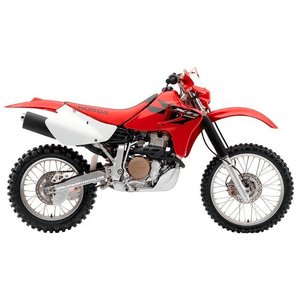Honda XR 650 R (2000–2007): The Unrelenting Desert Legend
Introduction
The Honda XR 650 R isn’t just a motorcycle—it’s a statement. Built during an era when dual-sport bikes were transitioning from rudimentary trail machines to precision off-road weapons, the XR 650 R carved its niche as a desert sled, a Baja conqueror, and a reliable companion for riders who demanded durability alongside raw power. From 2000 to 2007, this liquid-cooled beast dominated the "big bore" enduro segment, blending Honda’s signature reliability with enough grunt to tackle everything from rocky singletrack to wide-open fire roads. After spending a week with a well-maintained 2005 example, here’s why this motorcycle remains a benchmark for off-road enthusiasts.
Design & Build: Purpose-Bold and Unapologetically Tall
Ergonomics & Stance
Swinging a leg over the XR 650 R immediately reveals its intent: this is a machine built for riders who eat vertical challenges for breakfast. The seat height—935 mm (36.8 inches)—is towering, ideal for standing attacks on technical terrain but intimidating for shorter riders. The narrow seat profile helps, though, allowing some wiggle room to reach the ground. At 125–129 kg (276–285 lbs) dry weight, it’s surprisingly manageable for a 650cc thumper, especially once moving.
The steel frame and aluminum subframe strike a balance between rigidity and flex, absorbing impacts without feeling vague. Honda’s choice of a 46mm Kayaba cartridge fork up front and Pro-Link Kayaba shock at the rear (both fully adjustable) was revolutionary at the time. Even by modern standards, the suspension travel—284 mm (11.2 inches) front and 307 mm (12.1 inches) rear—delivers confidence on whoops and jagged trails.
Aesthetics & Functionality
The XR 650 R’s design is minimalist but purposeful. The angular red plastics and slim fuel tank (9.8–11.8 L / 2.6–3.1 US gal) scream ’00s dirt bike aesthetics, while the high-mounted front fender and underslung exhaust prioritize practicality. Ground clearance of 305 mm (12 inches) ensures rocky outcrops and fallen logs rarely scrape the chassis.
Engine & Performance: A Torque Monster With a Wild Streak
The Heart of the Beast
At the core of the XR 650 R lies a 649cc liquid-cooled single-cylinder engine—a rarity in an era when air cooling still dominated the dual-sport world. With 61 HP (45 kW) @ 6,750 RPM and 64 Nm (47.2 lb-ft) @ 5,500 RPM, this isn’t just a tractor; it’s a torque-driven sledgehammer. The Keihin 40mm carburetor provides crisp throttle response, though it demands patience in cold starts.
On dirt, the power delivery is euphoric. The engine pulls relentlessly from idle, churning through loose sand or mud without bogging down. On paved roads, the 5-speed gearbox’s tall first gear can feel cumbersome, but once you hit third, the XR transforms into a mile-crushing machine capable of 164 km/h (102 mph).
Heat Management & Quirks
Liquid cooling keeps temps in check during slow crawls, but the radiator’s exposed position demands a skid plate for serious off-roading. The engine’s 10.0:1 compression ratio and SOHC valvetrain are bulletproof, though valve adjustments (0.15 mm intake / 0.20 mm exhaust, cold) are frequent for high-revving riders.
On-Road vs. Off-Road Handling: A Study in Contrasts
Off-Road Dominance
The XR 650 R thrives where roads end. The 21-inch front and 18-inch rear wheel combo (80/100-21 and 110/100-18 tires, typically) floats over ruts, while the suspension soaks up landings from jumps that’d bottom out lesser bikes. Standing on the pegs feels natural, with the wide handlebar offering leverage to muscle through switchbacks.
On-Road Compromises
On pavement, the XR’s aggressive ergonomics and knobby tires remind you it’s a fish out of water. The seat is punishing after an hour, and the lack of a sixth gear makes highway cruising buzzy. Still, the single 240mm disc brakes (front and rear) provide adequate stopping power, though modern riders might crave ABS.
Competition: How the XR 650 R Stacks Up
Yamaha WR450F
The WR450F is lighter (112 kg / 247 lbs) and nimbler, ideal for tight trails. However, its 450cc engine lacks the XR’s low-end torque, and maintenance intervals are shorter.
KTM 525 EXC
KTM’s 525 EXC is a race-ready beast with sharper suspension and hydraulic clutch feel. But its complexity and higher price tag deterred riders seeking Honda’s simplicity.
Suzuki DR650
The air-cooled DR650 is more road-friendly, with a lower seat and cushier ride. Yet its softer suspension and 43 HP engine can’t match the XR’s off-road prowess.
Verdict: The XR 650 R strikes a rare balance between brute strength and reliability. It’s not the lightest or most modern, but it’s the bike you’d trust to cross a desert and return in one piece.
Maintenance: Keeping the Legend Alive
Key Service Points
- Valve Checks: Every 1,000 km (620 miles) for aggressive riders. Stick to the 0.15 mm (intake) and 0.20 mm (exhaust) clearances.
- Oil Changes: Use SAE 10W-40 (2.1 L with filter). Frequent changes (every 15–20 hours) are critical for the high-revving engine.
- Chain & Sprockets: The 14/45 sprocket combo wears quickly in muddy conditions. Upgrade to a DID 520 chain for longevity.
- Carburetor Tuning: The Keihin 40mm carb loves clean fuel but hates ethanol. Install an aftermarket fuel filter to prevent clogs.
MOTOPARTS.store Upgrades
- Air Filters: Swap the stock filter for a twin-air foam kit to boost airflow in dusty environments.
- Skid Plates: Protect the engine and radiator with an aluminum skid plate.
- Suspension Springs: Heavier riders should consider stiffer springs for the Kayaba suspension.
- LED Lighting Kits: Convert to LED for better visibility during night rides.
Conclusion: The Ultimate Desert Companion
The Honda XR 650 R isn’t just a relic of the 2000s—it’s a testament to engineering that prioritizes function over frills. Yes, it’s tall, loud, and demands your attention in the garage. But when you’re carving through a canyon or leading a pack into the dunes, there’s nothing quite like the roar of that 649cc single beneath you. For riders who value mechanical simplicity and earth-moving torque, the XR 650 R remains a legend worth owning—and cherishing.



















